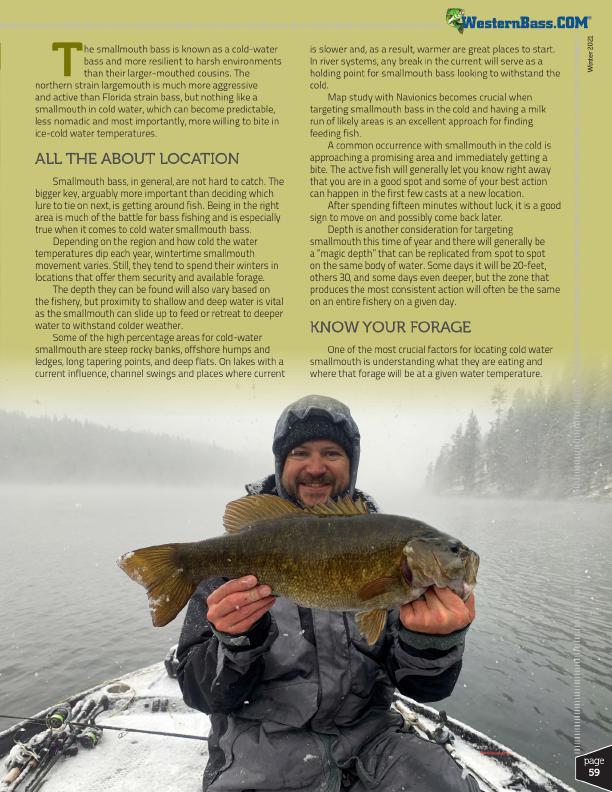
Winter 2021
T
he smallmouth bass is known as a cold-water
bass and more resilient to harsh environments
than their larger-mouthed cousins. The northern strain largemouth is much more aggressive
and active than Florida strain bass, but nothing like a
smallmouth in cold water, which can become predictable,
less nomadic and most importantly, more willing to bite in
ice-cold water temperatures.
ALL THE ABOUT LOCATION
Smallmouth bass, in general, are not hard to catch. The bigger key, arguably more important than deciding which lure to tie on next, is getting around fish. Being in the right area is much of the battle for bass fishing and is especially true when it comes to cold water smallmouth bass.
Depending on the region and how cold the water temperatures dip each year, wintertime smallmouth movement varies. Still, they tend to spend their winters in locations that offer them security and available forage.
The depth they can be found will also vary based on the fishery, but proximity to shallow and deep water is vital as the smallmouth can slide up to feed or retreat to deeper water to withstand colder weather.
Some of the high percentage areas for cold-water smallmouth are steep rocky banks, offshore humps and ledges, long tapering points, and deep flats. On lakes with a current influence, channel swings and places where current
is slower and, as a result, warmer are great places to start. In river systems, any break in the current will serve as a holding point for smallmouth bass looking to withstand the cold.
Map study with Navionics becomes crucial when targeting smallmouth bass in the cold and having a milk run of likely areas is an excellent approach for finding feeding fish.
A common occurrence with smallmouth in the cold is approaching a promising area and immediately getting a bite. The active fish will generally let you know right away that you are in a good spot and some of your best action can happen in the first few casts at a new location.
After spending fifteen minutes without luck, it is a good sign to move on and possibly come back later.
Depth is another consideration for targeting smallmouth this time of year and there will generally be a “magic depth” that can be replicated from spot to spot on the same body of water. Some days it will be 20-feet, others 30, and some days even deeper, but the zone that produces the most consistent action will often be the same on an entire fishery on a given day.
KNOW YOUR FORAGE
One of the most crucial factors for locating cold water smallmouth is understanding what they are eating and where that forage will be at a given water temperature.
®
page 59